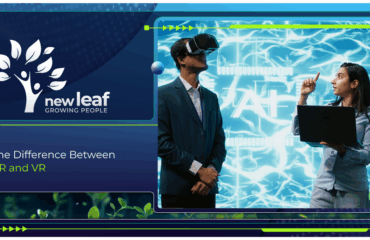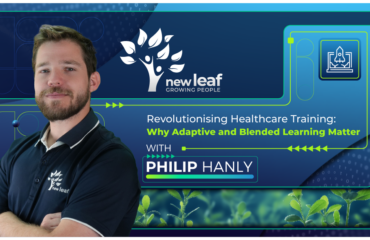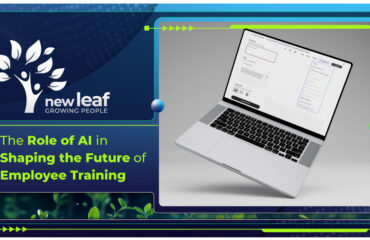
Remember when 2025 felt like a distant, sci-fi-inspired dream? Well, here we are – living in a time when technology evolves so quickly that it’s nearly impossible to keep up. Among the most transformative technologies of the moment are artificial intelligence (AI) and augmented reality (AR), two innovations fundamentally reshaping how learners interact with digital education.
Let’s take a closer look at how these tools are redefining the eLearning experience.
AI in Personalised and Adaptive Learning
AI systems are designed to perform tasks that usually require human intelligence, such as understanding language, making decisions, recognising patterns, and solving complex problems. It encompasses various subfields, including Machine Learning (ML), Natural Language Processing (NLP), robotics, computer vision, and more. Here’s how these fields are revolutionising L&D in 2025.
Creating personalised learning paths
AI has moved beyond being a buzzword to becoming indispensable in delivering personalised learning at scale. Adaptive courseware powered by AI enables learners to progress through content that is tailored to their individual needs, learning styles, and pace. AI can generate personalised content, from microlearning modules to interactive simulations, that adapt in real-time to a learner’s progress. It analyses data from various sources, such as employee job roles, performance metrics, and learning preferences, to automatically create tailored learning experiences.
After implementing personalised learning paths in their training programs, our client, Wellness Warehouse, saw completion rates skyrocket from 25% to 98%, which shows just how powerful personalisation is. The main benefit of personalised learning paths is that it ensures that employees receive the right training at the right time, are more engaged, and spend less time on irrelevant material. For instance, an AI-powered system can detect when an employee struggles with a particular concept and immediately generate additional exercises or resources to address the gap.
Generating content
Generative AI tools are revolutionising content creation by automatically generating learning materials based on predefined learning objectives. They can flag outdated or irrelevant content and update new training materials quickly and at scale. It draws from a vast array of existing company data, industry trends, and real-time information to create relevant and up-to-date content, minimising manual intervention.
AI can create and repurpose content, including text, multimedia, interactive content, and simulations, all the while analysing user behaviour and preferences to recommend relevant learning materials, resources, and courses based on the individual’s preferences or progress.
It can generate quizzes and tests based on courseware, and AI-powered assessment tools can dynamically adjust the type and difficulty of questions based on learner responses, providing L&D leaders with more accurate insights into students’ mastery of the material.
Analysing data
With the proliferation of digital learning tools, the volume of student-generated data has grown exponentially, necessitating AI technology that can analyse data at scale. This is essential to gain insights into learning trends, student engagement, and areas that can be improved at both the individual and institutional levels.
AI can even track and predict student success, allowing for timely interventions to improve outcomes and identifying unique learning styles to tailor content. By analysing trends and patterns in student data, educators can identify the most effective content and teaching methods for their students, as well as the gaps in the curriculum.
New Leaf Technologies’ Training Intelligence System fills the data tracking and analysis gap often found in learning management systems. It combines data from numerous sources, unlocking complete insight into training data through customisable visual reporting dashboards accessible in real-time.
Chatbots and virtual assistants
AI chatbots have become a game-changer in eLearning, taking on the role of personalised tutors. NLP technologies enable conversational interfaces, chatbots, and virtual assistants to analyse, interpret, and respond to natural language queries and answer questions instantly. They can guide learners and personalise responses based on user preferences and past interactions.
Intelligent bots can also initiate peer-to-peer interactions that boost learner collaboration and productivity. Some more advanced bots can offer visual elements such as images, icons and videos. By embedding these elements, the conversations become more interactive and engaging.
Combining AI with augmented and virtual reality
Before we dive into how AI is revolutionising learning by merging with augmented, virtual and mixed realities, let’s recap what each means:
- Augmented reality (AR) overlays digital elements—such as text, images, or 3D objects—onto the real world using a device like a smartphone, tablet, or AR glasses. You still see and interact with the real world, but digital enhancements are added to your surroundings.
- Virtual reality (VR) fully immerses you in a completely digital, computer-generated environment, cutting you off from the real world. Using a VR headset, learners can perform risky and dangerous tasks without making costly mistakes or exposing themselves to injury.
- Mixed Reality (MR) is an advanced form of AR. It blends the real and virtual worlds, allowing you to interact with both physical and digital elements simultaneously, seamlessly merging them into one environment.
These technologies are being used by training institutes across the world, especially in the medical, aviation and electronics fields, where hands-on training is essential. In many cases and across industries, they can eliminate the need for instructors, physical resources, and materials. And because they are adaptable and scalable, they hold enormous potential for creating sustainable and standardised L&D programs.
A Yale study showed that AI’s superior ability to immerse the learner can lead to workers being 29% faster and making six times fewer errors. Also, when you bring AI into a virtual environment, you bring a level of humanity to the lesson, turning AI into the best instructor your team has ever had.
How does it work?
While AR or VR immerses learners in the learning journey, AI personalises it and creates opportunities for new content generation. Combined, AI changes sequences as it learns from the students and updates lessons based on learners’ knowledge.
One of the most impactful examples of its application is in industries like retail pharmacies, pharma, and healthcare. For one, because these industries are exposed to rapid advancement and stringent regulatory requirements, AI is a highly effective way to ensure training remains compliant with the latest standards.
In the pharmaceutical industry, for example, employees and learners can use AI-driven learning platforms to quickly upskill on new drug formulations, including their interactions with other medications. Or, they can access virtual labs, attend AR health and safety training, and collaborate with peers across the globe in live or simulated training sessions.
Healthcare Education
In healthcare education, AR and VR can mimic the complexities of real-life patient care, allowing students to learn through experiential and immersive, realistic scenarios that bridge the gap between theory and practice. AR aids surgeons by overlaying digital information onto the physical world (their patients), improving precision and outcomes during procedures, and allowing students to visualise and interact with 3D models of anatomy.
For companies and franchises with a large number of employees that need to be trained, AI-powered AR and VR training will be more affordable than complex, time-consuming traditional training methods. Our experience shows that once the infrastructure is in place, the cost per trainee is reduced significantly.
Instead of requiring one-on-one instruction, trainees can access AR training modules on demand, at any time, and from any location. This is especially beneficial for organisations with dispersed teams or remote workers. AI-powered AR extends the shelf-life of eLearning programs by creating dynamic, interactive, and adaptable evergreen content that remains relevant even as workplace technologies and procedures evolve.
Ready to explore future-facing eLearning solutions?
AI and augmented and virtual reality are not just transforming how we learn; they are setting the stage for the future of work itself. It is in step with digital transformation, it’s the future of learning, and it’s what employees and learners want.
If you’re ready to harness the power of these cutting-edge technologies, New Leaf Technologies can help you create innovative, future-ready eLearning solutions. Get in touch today, and let’s shape the future of learning together.




